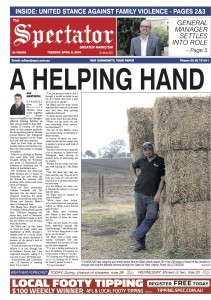The Hamilton Spectator – April 05, 2016
FARMERS from the Western District have come together to donate straw to bushfire and drought- affected farming families so they can get back on their feet.
Instead of burning off excess straw as they prepare paddocks for the upcoming season, farmers around Harrow and Telangatuk East have donated it to the ‘Need for Feed’ and other charities.
Need for Feed links up straw and hay donors with farmers who have lost their pasture to drought or bushfire.
There is no shortage of farmers who need help, with record droughts hitting the Wimmera and areas of Queensland, and bushfires at Scotsburn and Mt Bolton in the Ballarat area.
The Scotsburn fire destroyed 4000 hectares and 12 houses in December last year while the Mt Bolton fire claimed 1300 hectares, three homes and seven sheds in February.
Need for Feed coordinator Graham Cockerell told The Spectator that the largest non- corporate donations the group had ever received had come from Warren and Jasmine Blake’s farm in Telangatuk East.
The Blakes have already seen 210 bales of straw picked up from their 3200-acre cropping and sheep farm, north of Balmoral, and The Spectator spoke to them the day before the last 50 bales were taken away.
Mr Blake said he first heard of Need for Feed, which was established in 2006, through a random post on a social media website and almost dismissed it because of the group’s lack of online members.
“It was advertised on Facebook, believe it or not, through one of Graham’s friends, and I just responded basically asking if it was real or not,” Mr Blake said.
“It snowballed, and I said there was 110 hectares of standing straw if you want it.
“I’m just going to burn it and I thought it would be better to get rid of it rather than burn it and see it go up in smoke.”
Mr Blake said the straw would help feed the livestock of farmers who had seen their grazing paddocks destroyed.
“It saves money and helps feed their stock, that’s the main thing.
“When you get burnt out you lose everything. Stock survive, but feed doesn’t.”
The last of the Blakes’ straw was hauled away on Saturday at about midday.
A convoy of about six semi-trailer trucks and two escort utes is needed to pick up each load of donated straw.
The prior convoys have attracted a lot of attention in Harrow and Telangatuk East, serving as another form of advertising for the charity.
“People see the trucks and they ask what’s going on,” Mrs Blake said.
“You tell them why they are there and they say ‘ring us, we’ll help you load. It’s too late this year (for us to donate ourselves) but next year’.”
For the Blakes, the main cost is through the labour to cut and bale the straw.
Mr Blake says he donated to “pay it forward”.
“We’ve been there before, we’ve been burnt out and people helped us. What comes around goes around.”
Mrs Blake said Facebook also helped in that they could see pictures of when the straw arrived.
“They can see where it’s come from, especially through that Facebook page,” Mrs Blake said.
“It’s the best thing about it: you get to see the faces.”
Mr Blake said a local straw cutting contractor had also volunteered his services to help get the straw prepared.
“I’ve got a bailing contractor to do it for nothing; it’s coming out of his pocket to bale it,” he said.
“It’s coming out of my pocket to cut it; it’s coming out of (Need for Feed’s) pocket to cart it.
“It’s just Australia.”
